- Home
- Fly-In
- History
- Clinton2002
- What I did on my Summer Vacation: Stories from Clinton 2002 Royson part2
by Royson Parsons N9YX
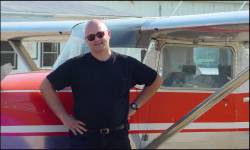 My flight home from Clinton to California in the 150 was both mundane and challenging. This is my third long cross country trip home from Clinton, and I’ve become more casual about flight planning with each one. How’s this for spontaneity? My only confirmed destinations were Cavern City, NM, Phoenix, AZ and Home. When leaving Clinton I simply set my GPS for “Direct To” Cavern City, which turned out to be 875 miles.
My flight home from Clinton to California in the 150 was both mundane and challenging. This is my third long cross country trip home from Clinton, and I’ve become more casual about flight planning with each one. How’s this for spontaneity? My only confirmed destinations were Cavern City, NM, Phoenix, AZ and Home. When leaving Clinton I simply set my GPS for “Direct To” Cavern City, which turned out to be 875 miles. I flew the direct route as much as possible, scrolling ahead on the GPS map to see where I might want to stop every two and half hours or so. The problem with this plan? You can’t be sure about the availability of fuel and food, but having stopped at many of these airports before I had some seat of the pants knowledge about what made a good stop.
Day One, Friday: Left Clinton at 2 pm and ended up stopping in Davenport, IA (for charts) and Fairfield, IA where the biggest crisis was adding salt to my coffee. (I ask you, does the big sugar looking canister of salt belong next to the coffee machine?) Then on to Rosecrans, MO, followed by Manhattan, KS. My brother Bruce promised me that a family Barbeque restaurant in Liberal, Kansas was well worth the effort, so that’s where I was headed. As it began to get dark around 9 pm I noted that headwinds were really cutting into my progress. I had expected to arrive in Liberal by 10pm but at the current rate of groundspeed I wouldn’t arrive till after midnight and one more fuel stop would be required. One thing I’ve learned from the previous trips is that the later it gets the harder it is to find fuel and lodging. Having flown more than 6 hours at that point I decided it was time to settle in for the night, and chose the nearest large looking town, Salina, KS.
Salina turned out to be the most challenging landing of my life so far. AWOS reported that the winds were strong, 25kts gusting to 33kts but right down runway 17. As I descended for the airport I was bouncing around pretty good and finding it difficult to stay on course. The tower had closed for the night and the frequency was quiet until I made my first report about 10 miles out. That’s when a Lear Jet reported 30 miles. I began to calculate the laws of physics in my head.
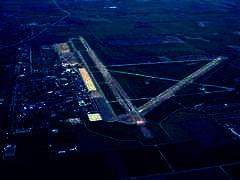 Let’s see, at 60 knots ground speed I’ll be at the airport in about 10 minutes, assuming 250-300kts for the Lear will put him in the pattern at roughly the same time as me. I glanced at the airport guide book, and began my usual process of pilot Zen, trying to picture my airplane in the airspace, comparing my heading to the runways, and how I would enter the pattern appropriately, hopefully without inconveniencing the Lear guys who in my mind “owned” the airspace.
Let’s see, at 60 knots ground speed I’ll be at the airport in about 10 minutes, assuming 250-300kts for the Lear will put him in the pattern at roughly the same time as me. I glanced at the airport guide book, and began my usual process of pilot Zen, trying to picture my airplane in the airspace, comparing my heading to the runways, and how I would enter the pattern appropriately, hopefully without inconveniencing the Lear guys who in my mind “owned” the airspace.
My heading was roughly 250, so I was set up for a left base entry to 17 which would save time, not having to enter on the downwind. At 3 miles I clicked on the runway lights, and got a surprise. Two runways lit up in a neat “<” with me set up for left base entry to either one. Which one was 17? I grabbed the airport guide, saw that the other runway was 13, and attempted to reset my Zen to the new information, turning the book diagram this way and that in a vain attempt to recalibrate my mental GPS. This was an excellent time for the Lear to report 10 miles. I reminded myself to “Fly the Plane” dropped the airport guide onto the seat, and looked at the runways. The runway furthest out was quite distinctly better lit, the lit up one must be the active right? I made my base turn to final as the Lear reported 5 miles, damn! Those babies are fast…I unconsciously kept my speed up trying to stay out of their way, and got involved with some pretty serious buffeting on short final. Crossing the numbers set off a little mental alarm, “What’s that? 13! 13 not 17? Uh oh.” I got pretty busy making my most unusual crosswind landing ever, no flaps, too fast, with a 40 degree 25kt crosswind gusting to 33. Let’s just say it took a long time to get it planted, and by then the Lear was on short final. Having landed long and realizing that the two runways intersected my worries weren’t over, but I managed to cool off sufficiently to adopt an “all in a day’s work” attitude by the time I got tied down.
The Lear guys were already schmoozing with the attractive all female night staff in the FBO, “Are you the guy that just landed in the 150? Wow! You landed on the crosswind runway too! You must be nuts!!” Well, yes actually, pretty much…
Turns out there was world series youth softball tournament in town that weekend with numerous tailgate parties. When I checked into the motel another guest (noticing my club T shirt) asked me if I was a pilot. When I said yes, he asked “That wasn’t you that just flew in a little Cessna about half an hour ago was it?” Yes… “Oh my gosh, we were having a tailgate party in the parking lot and watched you come in, you were bouncing all over the place, you must be crazy!” Crazy or nuts, take your pick.
Day Two, Saturday: First thing in the morning I headed out for Liberal, KS, where the food was as good as promised and I actually took the time to do a little sightseeing. Somewhere along the line Liberal decided it might be good for tourism if they were the “Wizard of Oz” town, so they adopted the slogan “The Land of OZ” , named a street “Yellow Brick Road” and advertised tours of Dorothy’s house. Problem is, Yellow Brick Road was slightly less than easy to spot, despite being in the heart of downtown. It took me three U turns at the “Just ahead” signs to find the place. Worse, it wasn’t Dorothy’s house after all, but merely a similar looking structure that was donated by a local resident after apparently numerous quips of “Did you know your house looks just like the house in The Wizard of OZ?”
For pilots, there actually is an OZ in Liberal, in the form of the Mid America Air Museum, fifth largest air museum in the country, and the largest primarily devoted to general aviation. (while there are a few “military” airplanes on display, they are of the Beech Staggerwing / Cessna Bobcat variety) The museum is located in a huge non air-conditioned hangar at the airport, with 99 airplanes. My visit was brief, about a half an hour, but I found the non nonsense displays refreshing. This is a place for real pilots to enjoy looking at real airplanes, parked like they would be in anyone’s hangar. No B17’s or P51’s in this crowd. Unfortunately, there wasn’t a Cessna 150 or 152 either, though there were fine examples of both a 120 and a 140 as well as a 175, a couple of 195’s.
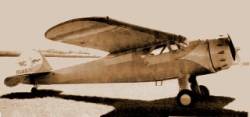 What I found extremely special at Mid America was Dwane Wallace’s personal airplane, a C165 Airmaster. Dwane was Clyde Cessna’s nephew, and began working at the then bankrupt company right out of college. Turns out the C165 was Dwane’s first major project as the new head of Cessna in January of 1934. Dwane first flew the airplane in August of that year, and ended up personally flying it in numerous competitions around the country, rebuilding Cessna’s reputation during the depression. Company legend has it that Dwane often used prize money won racing the Airmaster to meet the company's modest payroll.
What I found extremely special at Mid America was Dwane Wallace’s personal airplane, a C165 Airmaster. Dwane was Clyde Cessna’s nephew, and began working at the then bankrupt company right out of college. Turns out the C165 was Dwane’s first major project as the new head of Cessna in January of 1934. Dwane first flew the airplane in August of that year, and ended up personally flying it in numerous competitions around the country, rebuilding Cessna’s reputation during the depression. Company legend has it that Dwane often used prize money won racing the Airmaster to meet the company's modest payroll.
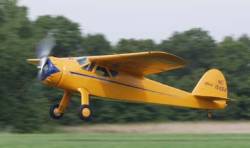
The C165 was ultimately awarded a trophy as “The World’s most Efficient Airplane.” Thanks to Mr. Wallace, Cessna eventually became the largest and most important general aviation company. After the C165’s glory days, it was retired to a hangar at headquarters with just 1,600 hours on the tach. Forty four years later, after he had retired, Dwane Wallace obtained the airplane from Cessna and spent three years restoring it to it’s original condition. He flew it to numerous events around the Midwest, and it was awarded Grand Champion at the Kansas Annual Antique Fly-In. After Mr. Wallace passed away, his wife Velma donated the Airmaster to the Mid America Museum.
I stood in awe looking at Dwane Wallace’s C165 Airmaster. Here in the flesh was the airplane responsible for the survival of the Cessna Company, and by extension for much of my own involvement in aviation. Dwane designed this plane, built it, flew it, rebuilt it and flew it again. In spite of museum rules, I reached out and felt the smooth curve of NC32450’s cowl. It was an emotional experience that brought tears to my eyes. I’ve seen many of the most famous airplanes in some of the finest aviation museums worldwide, but none ever touched me personally like Dwane Wallace’s 165 Airmaster.
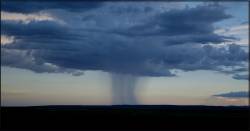
The rest of my flying that day was punctuated by true enjoyment of the scenery from 2,500 ft. Next stop was Hereford, TX, which of course I mispronounced on CTAF, (the second e is supposed to be silent.) Texas skies were really dramatic, with towering thunderheads right next to the airport on my departure. The last leg of the day crossing into New Mexico was unique because I enjoyed the scenery more than ever before. I felt comfortable enough with the airplane and myself to actually take of my headset for more than an hour and take a good look around. I was rewarded with some amazing weather and beautiful terrain, topped by a spectacular sunset after I landed in Carlsbad New Mexico (Cavern City).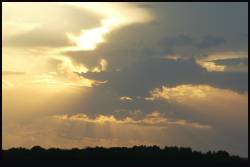
Having only flown 7.3 hours that day, I fully expect to push on, at least to Deming, where I knew they had fuel and Motels, but unfortunately, Cavern City’s FBO had gone home for the day, so I decided to stay. I noted some changes from last year, no doubt the result of 9/11. Unlike before, the inviting terminal with it’s pay phones and restrooms was locked up tight. I also noted a stern warning that access to the ramp was only by permission of the airport manager (note that Carlsbad has some kind of semi regularly scheduled shuttle service.)

Laughably, the electric access gate to the ramp was left wide open, not that it would have made much difference as the combination was posted in 4 inch tall letters on the gate. It added up to a ridiculous joke meant to reassure the flying public, but really doing nothing except inconveniencing GA pilots. No phones, no bathrooms, no place to sit down and regroup save some cement steps in the dark. United we stand, divided we sit.
Day Three, Sunday: Really wanted to push on all the way home, but had my doubts as I had at least 10 hours of flying to go. Spent much of my desert flying enjoying the sites, including a most amazing dust storm outside of Las Cruces, NM. Dust was rolling across the terrain in a weird single file blanket, I was so amazed I broke out the camcorder and got some footage. My stops throughout the day were as short as possible, top off fuel, top off bladder with a cold drink, check the oil, and off to the next stop. Carlsbad to Deming, NM, 2.4 hrs, Deming to Chandler, AZ (Phoenix) 2.8 hours, Chandler to Apple Valley, CA a somewhat grueling 3.3 hours (not much to look at and slower speed for best fuel endurance.) Finally Apple Valley to Paso Robles (home) Time in the air for day three: 11 hours. Time in the air since I left Clinton on Friday: 24.4 hours. Time on the airplane since I left for Clinton Back on May 5th: 50.2 hours. What an amazing trip it turned out to be.
Royson Parsons aka Kojack N9YX